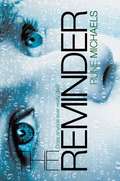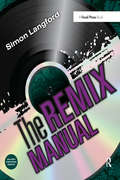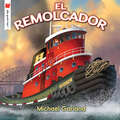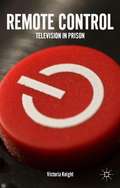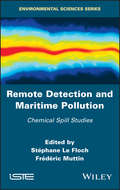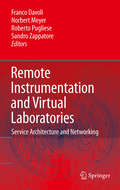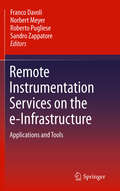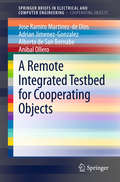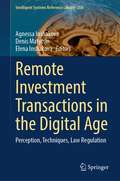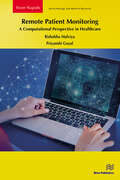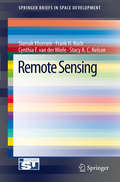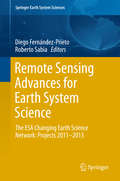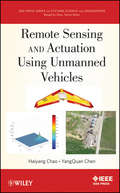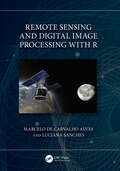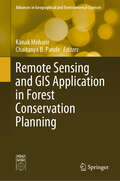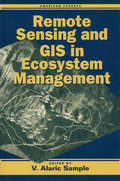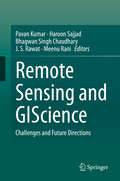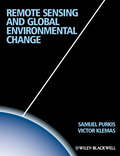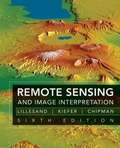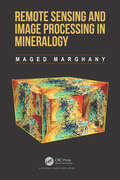- Table View
- List View
Remembrance of Things Present: The Invention of the Time Capsule
by Nick YablonTime capsules offer unexpected insights into how people view their own time, place, and culture, as well as their duties to future generations. Remembrance of Things Present traces the birth of this device to the Gilded Age, when growing urban volatility prompted doubts about how the period would be remembered—or if it would be remembered at all. Yablon details how diverse Americans – from presidents and mayors to advocates for the rights of women, blacks, and workers – constructed prospective memories of their present. They did so by contributing not just written testimony to time capsules but also sources that historians and archivists considered illegitimate, such as photographs, phonograph records, films, and everyday artifacts. By offering a direct line to posterity, time capsules stimulated various hopes for the future. Remembrance of Things Present delves into these treasure chests to unearth those forgotten futures.
The Reminder
by Rune MichaelsDaisy, otherwise known as Daze, keeps hearing her dead mother's voice. Sometimes it's because of her dad, who likes to watch old home movies when he can't sleep. Sometimes it's because of her brother, who was too young to remember Mom, and needs to be reminded by looking at photographs and watching videos. Sometimes it might just be her mind trying to work out what her therapist would call "issues." But this time, it is none of those things. It's something much more wonderful and much more terrifying, something Daze never thought possible. And it might allow Daze to do what she couldn't years ago: save her mother's life. Rune Michaels, the visionary author of Genesis Alpha, plunges headfirst into the waters where science, family, and memory meet, and emerges with a powerful and fascinating story about loss and survival that challenges everything we think we know about the people we love.
The Remix Manual: The Art and Science of Dance Music Remixing with Logic
by Simon LangfordFirst published in 2011. Routledge is an imprint of Taylor & Francis, an informa company.
El remolcador (¡Me gusta leer!)
by Michael GarlandLos remolcadores son pequeños, pero fuertes. Con este atractivo libro ilustrado conocerás cómo estas embarcaciones de aspecto minúsculo ayudan a las barcazas y otros barcos. El pequeño y potente remolcador puede realizar grandes tareas: tirar de cruceros, trasladar cargueros, empujar barcazas y hasta transportar un puente. El remolcador ayuda a los barcos grandes a moverse en espacios pequeños y lleva de un lado a otro la barcaza de los fuegos artificiales. Hermosos dibujos de vibrantes escenas portuarias en todo tipo de clima ilustran un texto sencillo e informativo, escrito especialmente para los lectores más jóvenes. El índice de contenidos y el glosario ilustrado al final del libro complementan esta divertida experiencia de aprendizaje. Mejor libro infantil del año, según Bank Street College of Education. Incluido entre los mejores libros infantiles para la lectura familiar por el Pennsylvania Center for the Book Baker&’s Dozen. Exposición anual de la Society of Illustrators
Remote Control: Television in Prison
by Victoria KnightIn-cell television is now a permanent feature of prisons in England and Wales, and a key part of the experience of modern incarceration. This sociological exploration of prisoners' use of television offers an engaging and thought provoking insight into the domestic and everyday lives of people in prison - with television close at hand. Victoria Knight explores how television contributes to imprisonment by normalising the prison cell. In doing so it legitimates this space to hold prisoners for long periods of time, typically without structured activity. As a consequence, television's place in the modern prison has also come to represent an unanticipated resource in the package of care for prisoners.
Remote Detection and Maritime Pollution: Chemical Spill Studies
by Stéphane Le Floch Frédéric MuttinThe detection of marine pollution requires a scientific and operational response to identify contaminants, chemicals and hydrocarbons, and to support contrasting observations. Remote Detection and Maritime Pollution originates from the proceedings of CEDRE Information Day, held on October 13, 2016 in Brest, France. Containing four parts encompassing 13 chapters, this book explores remote detection channels for the multiform marine pollutions of today and of the future. With a focus on transatlantic cooperation, it covers remote detection sensors, the state of the art of maritime surveillance with regard to the interests of national and international authorities, the benefits of response strategy, and geophysical exploration. Future vectors (airplanes, drones, satellites, among others) and sensors (radar, optical, hyperspectral and so on) are also studied. This book is a valuable resource for practical solutions for marine authorities, industries (chemical, energy, aerospace, petroleum, shipping), lawyers and scientists.
Remote Instrumentation and Virtual Laboratories
by Sandro Zappatore Norbert Meyer Roberto Pugliese Franco DavoliAccessing remote instrumentation worldwide is one of the goals of e-Science. The task of enabling the execution of complex experiments that involve the use of distributed scientific instruments must be supported by a number of different architectural domains, which inter-work in a coordinated fashion to provide the necessary functionality. These domains embrace the physical instruments, the communication network interconnecting the distributed systems, the service oriented abstractions and their middleware. The Grid paradigm (or, more generally, the Service Oriented Architecture -- SOA), viewed as a tool for the integration of distributed resources, plays a significant role, not only to manage computational aspects, but increasingly as an aggregator of measurement instrumentation and pervasive large-scale data acquisition platforms. In this context, the functionality of a SOA allows managing, maintaining and exploiting heterogeneous instrumentation and acquisition devices in a unified way, by providing standardized interfaces and common working environments to their users, but the peculiar aspects of dealing with real instruments of widely different categories may add new functional requirements to this scenario. On the other hand, the growing transport capacity of core and access networks allows data transfer at unprecedented speed, but new challenges arise from wireless access, wireless sensor networks, and the traversal of heterogeneous network domains. The book focuses on all aspects related to the effective exploitation of remote instrumentation and to the building complex virtual laboratories on top of real devices and infrastructures. These include SOA and related middleware, high-speed networking in support of Grid applications, wireless Grids for acquisition devices and sensor networks, Quality of Service (QoS) provisioning for real-time control, measurement instrumentation and methodology, as well as metrology issues in distributed systems.
Remote Instrumentation for eScience and Related Aspects
by Roberto Pugliese Jan Węglarz Franco Davoli Norbert Meyer Marcin Lawenda Sandro ZappatoreThis book will focus on new Remote Instrumentation aspects related to middleware architecture, high-speed networking, wireless Grid for acquisition devices and sensor networks, QoS provisioning for real-time control, measurement instrumentation and methodology. Moreover, it will provide knowledge about the automation of mechanisms oriented to accompanying processes that are usually performed by a human. Another important point of this book is focusing on the future trends concerning Remote Instrumentation systems development and actions related to standardization of remote instrumentation mechanisms.
Remote Instrumentation Services on the e-Infrastructure
by Roberto Pugliese Norbert Meyer Franco Davoli Sandro ZappatoreThe book focuses on all aspects related to the effective exploitation of remote instrumentation and to the building of complex virtual laboratories on top of real devices and infrastructures. These include service oriented architecture (SOA) and related middleware, high-speed networking in support of Grid applications, wireless Grids for acquisition devices and sensor networks, Quality Service (QoS) provisioning for real-time control, measurement instrumentation and methodology, as well as metrology issues in distributed systems.
A Remote Integrated Testbed for Cooperating Objects (SpringerBriefs in Electrical and Computer Engineering)
by Jose Ramiro Martinez-de Dios Adrian Jimenez-Gonzalez Alberto San Bernabe Anibal OlleroTestbeds are gaining increasing relevance in research domains and also in industrial applications. However, very few books devoted to testbeds have been published. To the best of my knowledge no book on this topic has been published. This book is particularly interesting for the growing community of testbed developers. I believe the book is also very interesting for researchers in robot-WSN cooperation. This book provides detailed description of a system that can be considered the first testbed that allows full peer-to-peer interoperability between heterogeneous robots and ubiquitous systems such as Wireless Sensor Networks, camera networks and pervasive computing systems. The system architecture includes modules that allows full bidirectional communication between robots and WSN. One robot can The book describes the current state of the art in development of testbeds integrating Cooperating Object technologies. It describes in detail the testbed specification and design using requirements extracted from surveys among experts in robotics and ubiquitous systems in academia and industry. The book also describes the testbed novel architecture and its hardware and software components. Moreover, it includes details on user support tools to facilitate its use such as remote use using a virtual private network and sets of functionalities of interest for members from the robotics, WSN and robot-WSN communities. Finally, the book illustrates its capabilities and potentialities describing the implementation of some of the experiments that have been performed. Examples from the robotics, WSN and robot-WSN communities are described.
Remote Investment Transactions in the Digital Age: Perception, Techniques, Law Regulation (Intelligent Systems Reference Library #250)
by Agnessa Inshakova Denis Matytsin Elena InshakovaThe book contains the results of the best research developments obtained during the implementation of major scientific events organized and carried out with the financial support of the Russian Science Foundation and the President of the Russian Federation.The scientific novelty of the work lies in the fact that for the first time at the level of Russian and international interdisciplinary social and humanitarian sciences, primarily economic and legal, firstly, philosophical concepts and regulatory legal approaches to the regulation of remote investment transactions have been studied; secondly, a set of economic and legal conditions and means of harmonizing and observing the mutual interests of participants in remote investment transactions has been developed and proposed in order to prevent and minimize potential conflicts between the parties; thirdly, the current state and international regulation of investment transactions concluded and executed on Internet platforms was critically assessed; fourthly, a system of guarantees and protection of the rights of participants in remote investment transactions is proposed, including special contractual structures and an economic and legal model for the proper fulfillment of obligations.Measures are substantiated to expand and increase the intensity of the national investment turnover based on the improvement of the current legislation regulating investments through remote digital technologies in the Internet space, which provided a solution to the world scientific problem of great socioeconomic and economic importance. The book is designed for a wide target audience—scientists of different generations, different disciplinary and industry affiliations. Among them are young researchers, as well as scientists who have received recognition from the world scientific community, studying the socioeconomic, managerial, and legal consequences of the emergence and spread of digital technologies in the field of investment. Readers can be all individuals and legal entities interested in the development of digital technologies in the field of investment.
Remote Patient Monitoring: A Computational Perspective in Healthcare (River Publishers Rapids Series in Biotechnology and Medical Research)
by Rishabha Malviya Priyanshi GoyalThis book provides a multidisciplinary overview of the design and implementation of systems for remote patient monitoring and healthcare. Readers are guided through the components of such a system and shown how they could be integrated into a coherent framework for deployment in practice. The book ends with a discussion of case studies to provide practical examples and design methods for remote healthcare systems with different needs. This book contains information that will be helpful to undergraduate and postgraduate students, academic and professional researchers, and individuals who employ computational intelligence. By presenting new models of care and support, AI in medicine is having an impact on the entire value chain of clinical practice and the patient care delivery system. This is especially evident in telemedicine breakthroughs, where applications of AI are utilized to assist, complement, or create new forms of remote healthcare. Through the use of communications technology, telemedicine enables medical professionals to examine, diagnose, and treat patients remotely. Now, the technology might also integrate online diagnostics, etc., to increase the effectiveness of the healthcare system and enhance patient outcomes. By enabling elderly people to live independently, technological advancements in fields like remote patient monitoring (RPM) systems can revolutionize senior care. Medical diagnosis will improve, and remote patient monitoring will become simpler thanks to artificial intelligence. The resistance of many patients and doctors to using the telemedicine idea for medical visits will probably be overcome by AI automation.
Remote Sensing
by Siamak Khorram Frank H. Koch Cynthia F. van der Wiele Stacy A.C. NelsonRemote Sensing provides information on how remote sensing relates to the natural resources inventory, management, and monitoring, as well as environmental concerns. It explains the role of this new technology in current global challenges. "Remote Sensing" will discuss remotely sensed data application payloads and platforms, along with the methodologies involving image processing techniques as applied to remotely sensed data. This title provides information on image classification techniques and image registration, data integration, and data fusion techniques. How this technology applies to natural resources and environmental concerns will also be discussed.
Remote Sensing Advances for Earth System Science
by Diego Fernández-Prieto Roberto SabiaTo better understand the various processes and interactions that govern the Earth system and to determine whether recent human-induced changes could ultimately de-stabilise its dynamics, both natural system variability and the consequences of human activities have to be observed and quantified. In this context, the European Space Agency (ESA) published in 2006 the document "The Changing Earth: New Scientific Challenges for ESA's Living Planet Programme" as the main driver of ESA's new Earth Observation (EO) science strategy. The document outlines 25 major scientific challenges covering all the different aspects of the Earth system, where EO technology and ESA missions may provide a key contribution. In this framework, and aiming at enhancing the ESA scientific support towards the achievement of "The Challenges", the Agency has launched in 2008 a new initiative - the Changing Earth Science Network - to support young scientists to undertake leading-edge research activities contributing to achieve the 25 scientific challenges of the LPP by maximising the use of ESA data. The initiative is implemented through a number of research projects proposed and led by early-stage scientists at post-doctoral level for a period of two years which are summarized in this SpringerBrief. These projects undertake innovative research activities furthering into the most pressing issues of the Earth system, while exploiting ESA missions data with special attention to the ESA data archives and the new Earth Explorer missions.
Remote Sensing and Actuation Using Unmanned Vehicles
by Yangquan Chen Haiyang ChaoUnmanned systems and robotics technologies have become very popular recently owing to their ability to replace human beings in dangerous, tedious, or repetitious jobs. <P><P>This book fill the gap in the field between research and real-world applications, providing scientists and engineers with essential information on how to design and employ networked unmanned vehicles for remote sensing and distributed control purposes. Target scenarios include environmental or agricultural applications such as river/reservoir surveillance, wind profiling measurement, and monitoring/control of chemical leaks.
Remote Sensing and Cognition: Human Factors in Image Interpretation
by Raechel A. White Arzu Coltekin Robert R. HoffmanHuman factors play a critical role in the design and interpretation of remotely sensed imagery for all Earth sciences. Remote Sensing and Cognition: Human Factors in Image Interpretation brings together current topics widely recognized and addressed regarding human cognition in geographic imagery, especially remote sensing imagery with complex data. It addresses themes around expertise including methods for knowledge elicitation and modeling of expertise, the effects of different aspects of realism on the interpretation of the environment, spatial learning using imagery, the effect of visual perspective on interpretation, and a variety of technologies and methods for utilizing knowledge in the analysis of remote sensing imagery. <P><P>Written by leaders in the field, this book provides answers to the host of questions raised at the nexus of psychology and remote sensing. Academics and researchers with an interest in the human issues surrounding the use of remote sensing data will find this book to be an invaluable resource. The topics covered in this book are useful for both the scientific analysis of remote sensing imagery as well as the design and display of remote sensing imagery to facilitate a variety of other tasks including education and wayfinding. <P><P>Features <li>Brings together remote sensing, environmental, and computer scientists discussing their work from a psychological or human factors perspective <li>Answers questions related to aesthetics of scientific visualization and mathematical analysis of perceptible objects <li>Explains the perception and interpretation of realistic representations <li>Provides illustrative real-world examples <li>Shows how the features of display symbols, elements, and patterns have clear effects on processes of perception and visual search
Remote Sensing and Digital Image Processing with R
by Marcelo de Carvalho Alves Luciana SanchesThis new textbook on remote sensing and digital image processing of natural resources includes numerous, practical problem-solving exercises and applications of sensors and satellite systems using remote sensing data collection resources, and emphasizes the free and open-source platform R. It explains basic concepts of remote sensing and multidisciplinary applications using R language and R packages, by engaging students in learning theory through hands-on, real-life projects. All chapters are structured with learning objectives, computation, questions, solved exercises, resources, and research suggestions. Features Explains the theory of passive and active remote sensing and its applications in water, soil, vegetation, and atmosphere. Covers data analysis in the free and open-source R platform, which makes remote sensing accessible to anyone with a computer. Includes case studies from different environments with free software algorithms and an R toolset for active learning and a learn-by-doing approach. Provides hands-on exercises at the end of each chapter and encourages readers to understand the potential and the limitations of the environments, remote sensing targets, and process. Explores current trends and developments in remote sensing in homework assignments with data to further explore the use of free multispectral remote sensing data, including very high spatial resolution data sources for target recognition with image processing techniques. While the focus of the book is on environmental and agriculture engineering, it can be applied widely to a variety of subjects such as physical, natural, and social sciences. Students in upper-level undergraduate or graduate programs, taking courses in remote sensing, geoprocessing, civil and environmental engineering, geosciences, environmental sciences, electrical engineering, biology, and hydrology will also benefit from the learning objectives in the book. Professionals who use remote sensing and digital processing will also find this text enlightening.
Remote Sensing and Digital Image Processing with R - Lab Manual
by Marcelo de Carvalho Alves Luciana SanchesThis Lab Manual is a companion to the textbook Remote Sensing and Digital Image Processing with R. It covers examples of natural resource data analysis applications including numerous, practical problem-solving exercises, and case studies that use the free and open-source platform R. The intuitive, structural workflow helps students better understand a scientific approach to each case study in the book and learn how to replicate, transplant, and expand the workflow for further exploration with new data, models, and areas of interest. Features Aims to expand theoretical approaches of remote sensing and digital image processing through multidisciplinary applications using R and R packages. Engages students in learning theory through hands-on real-life projects. All chapters are structured with solved exercises and homework and encourage readers to understand the potential and the limitations of the environments. Covers data analysis in the free and open-source R platform, which makes remote sensing accessible to anyone with a computer. Explores current trends and developments in remote sensing in homework assignments with data to further explore the use of free multispectral remote sensing data, including very high spatial resolution information. Undergraduate- and graduate-level students will benefit from the exercises in this Lab Manual, because they are applicable to a variety of subjects including environmental science, agriculture engineering, as well as natural and social sciences. Students will gain a deeper understanding and first-hand experience with remote sensing and digital processing, with a learn-by-doing methodology using applicable examples in natural resources.
Remote Sensing and GIS Accuracy Assessment
by Ross S. Lunetta John G. LyonBased upon a special symposium sponsored by the U.S. Environmental Protection Agency (EPA), Remote Sensing and GIS Accuracy Assessment evaluates the important scientific elements related to the performance of accuracy assessments for remotely sensed data, GIS data analysis, and integration products. Scientists from federal, state, and local governments, academia, and nongovernmental organizations present technical papers which examine sampling issues, reference data collection, edge and boundary effects, error matrix and fuzzy assessments, error budget analysis, and change detection accuracy assessment. This compilation contains 20 chapters that represent important symposium outcomes.
Remote Sensing and GIS Application in Forest Conservation Planning (Advances in Geographical and Environmental Sciences)
by Kanak Moharir Chaitanya B. PandeThis book focuses on the challenges in conservation, management and protection of forests in India as well as other countries, using recently developed technologies. Various topics are discussed including remote sensing, GIS, land use land cover, forest conservation techniques, social economics effects, fire forecasting models and the effect of fire on natural resources, among others. The book provides multi-disciplinary overviews for academicians, administrators, policymakers and professionals involved in the diverse aspects of sustainable forest development, planning and management, and forecasting and extinguishing forest fires. The book helps readers better understand the development of forests by planning and management in India and other countries, with the following focuses: - Forest area conservation in India and other countries - Advanced techniques for planning and conservation of forest cover - Forest conservation modeling using remote sensing and GIS techniques - Forest fire forecasting models used in remote sensing and GIS environments
Remote Sensing and GIS in Ecosystem Management
by Al SampleRecent advances in remote-sensing technology and the processing of remote-sensing data through geographic information systems (GIS) present ecologists and resource managers with a tremendously valuable tool -- but only if they are able to understand its capabilities and capture its potential.Remote Sensing and GIS in Ecosystem Management identifies and articulates current and emerging information needs of those involved with the management of forest ecosystems. It explores the potential of remote-sensing/GIS technologies to address those needs, examining: the need for landscape-scale analysis to support forest ecosystem research and management current challenges in the development of remote-sensing/GIS applications case studies of different forest regions in the United States the potential for further development or declassification of military and aerospace remote-sensing/GIS technologies As well as providing important information for ecologists and resource managers, the book will serve as a valuable resource for legislative and judicial policymakers who do not have a technical background in either remote sensing or resource management but who are nonetheless called upon to make decisions regarding the protection and management of forest ecosystems.
Remote Sensing and GIScience: Challenges and Future Directions
by Pavan Kumar Haroon Sajjad Bhagwan Singh Chaudhary J. S. Rawat Meenu RaniThis book covers several themes related to forestry, agriculture, water, soil, urban, and atmospheric research. GIScience technology systems have increased in significance in recent decades and have the ability to acquire information at ground level with a higher spectral resolution using a field radio-spectrometer, which is a great improvement compared to other remote sensing systems. GIScience technology systems are widely used for solving and understanding the concept of forestry, crop, water resources, and related research themes. This book aims to advance the scientific understanding of GIScience technology and applications. The chapters present GIScience data integration with other sources such as LiDAR, Multi-spectral data and their applications in forestry, crop assessment, soil assessment, mineral mapping and related themes. The book will be of interest to geospatial experts, modellers, foresters, agricultural scientists, hyperspectral remote sensing and space community, ecologists and conservation communities, environmental consultants, big data compilers, and computing experts.
Remote Sensing and Global Environmental Change
by Sam J. Purkis Victor V. KlemasRemote Sensing plays a key role in monitoring the various manifestations of global climate change. It is used routinely in the assessment and mapping of biodiversity over large areas, in the monitoring of changes to the physical environment, in assessing threats to various components of natural systems, and in the identification of priority areas for conservation.This book presents the fundamentals of remote sensing technology, but rather than containing lengthy explanations of sensor specifications and operation, it concentrates instead on the application of the technology to key environmental systems. Each system forms the basis of a separate chapter, and each is illustrated by real world case studies and examples. ReadershipThe book is intended for advanced undergraduate and graduate students in earth science, environmental science, or physical geography taking a course in environmental remote sensing. It will also be an invaluable reference for environmental scientists and managers who require an overview of the use of remote sensing in monitoring and mapping environmental change at regional and global scales.Additional resources for this book can be found at: http://www.wiley.com/go/purkis/remote.
Remote Sensing and Image Interpretation (6th Edition)
by Thomas M. Lillesand Ralph W. Kiefer Jonathan W. ChipmanThis book can be used in two ways: as a textbook in introductory courses in remote sensing and image interpretation, and as a reference for the burgeoning number of practitioners who use geospatial information and analysis in their work.
Remote Sensing and Image Processing in Mineralogy
by Maged MarghanyRemote Sensing and Image Processing in Mineralogy reveals the critical tools required to comprehend the latest technology surrounding the remote sensing imaging of mineralogy, oil and gas explorations. It particularly focusses on multispectral, hyperspectral and microwave radar, as the foremost sources to understand, analyze and apply concepts in the field of mineralogy. Filling the gap between modern physics quantum theory and image processing applications of remote sensing imaging of geological features, mineralogy, oil and gas explorations, this reference is packed with technical details associated with the potentiality of multispectral, hyperspectral and synthetic aperture radar (SAR). The book also includes key methods needed to extract the value-added information necessary, such as lineaments, gold and copper minings. This book also reveals novel speculation of quantum spectral mineral signature identifications, named as quantized Marghany’s mineral spectral or Marghany Quantum Spectral Algorithms for Mineral identifications (MQSA). Rounding out with practical simulations of 4-D open-pit mining identification and monitoring using the hologram radar interferometry technique, this book brings an effective new source of technology and applications for today’s minerology and petroleum engineers. Key Features• Helps develop new algorithms for retrieving mineral mining potential zones in remote sensing data.• Solves specific problems surrounding the spectral signature libraries of different minerals in multispectral and hyperspectral data.• Includes over 200 equations that illustrate how to follow examples in the book.

